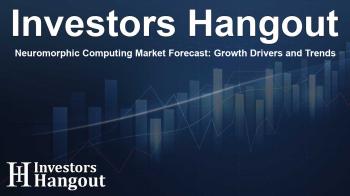Neuromorphic Computing Market Forecast: Growth Drivers and Trends

Introduction to the Neuromorphic Computing Market
The neuromorphic computing market is on the verge of significant expansion, with expectations to achieve a revenue of USD 55.6 billion by 2033, growing at a remarkable compound annual growth rate (CAGR) of 26.4%. This growth is attributed to the increasing development of computing systems that are modeled on the architecture and functions of the human brain, known as neuromorphic computing.
Understanding Neuromorphic Computing
Neuromorphic computing seeks to replicate the brain's neurological processes, enabling more effective and adaptive computations compared to traditional systems. Unlike conventional computing architectures that rely on the linear processing of data, neuromorphic computing employs neural networks and specialized hardware, allowing for biologically inspired information processing.
Applications of Neuromorphic Computing
This innovative technology is particularly advantageous in areas needing real-time decision-making, sensory processing, and pattern recognition, making it a crucial asset in various industries such as healthcare, robotics, consumer electronics, and beyond. As the demand for advanced AI capabilities grows, the adoption of neuromorphic computing is expected to follow suit.
The U.S. Neuromorphic Computing Landscape
In the United States, the neuromorphic computing market is projected to reach USD 2.3 billion by the year 2024, driven primarily by advancements in artificial intelligence (AI) and activities in high-stakes sectors such as military and healthcare. Notable collaborations between government agencies and academic institutions have facilitated innovation and development in this field.
Market Challenges
Despite its potential, challenges persist. High development costs, complex hardware requirements, and a lack of standardized frameworks pose hurdles for wide-scale adoption. As companies strive to integrate neuromorphic systems into their operations, overcoming these barriers remains a focal point.
Key Market Insights
The neuromorphic computing market is expected to witness substantial growth, with forecasts indicating an increase of USD 47.3 billion by 2033 from 2025 levels. Notably, the hardware segment is anticipated to dominate in the coming years. Applications across various sectors—from consumer electronics to autonomous systems—are paving the way for this burgeoning market.
Technological Advancements
Emerging trends show a rise in AI-driven applications utilizing neuromorphic chips, particularly in speech and image recognition technologies. This is complemented by a growing emphasis on energy-efficient computing, which is essential in today’s environmentally conscious landscape.
Competitive Landscape of Neuromorphic Computing
The competitive environment in the neuromorphic computing sector is vibrant, with major players such as IBM Corp, Intel Corp, Qualcomm Technologies, General Vision Inc, and Samsung Electronics spearheading innovation. Their focus on developing energy-efficient chips is critical for enhancing the capabilities of AI and smart systems.
Future Prospects
A growing emphasis on autonomous systems, including robotics and self-driving vehicles, highlights the increasing demand for neuromorphic solutions. Efforts to lower hardware complexity and refine integration methods will be essential in scaling these technologies effectively.
Conclusion
As the neuromorphic computing market matures, it opens doors to groundbreaking advancements in sectors reliant on rapid data processing and decision-making capabilities. The interplay of market challenges and technological strides will shape the future landscape of this dynamic field, paving the way for widespread adoption and innovative applications.
Frequently Asked Questions
What is neuromorphic computing?
Neuromorphic computing involves designing computing systems based on the structure and function of the human brain, allowing for more adaptive and efficient data processing.
What industries are most impacted by neuromorphic computing?
Industries such as healthcare, robotics, consumer electronics, and military applications are significantly impacted by neuromorphic computing technologies.
How fast is the neuromorphic computing market expected to grow?
The neuromorphic computing market is projected to grow at a CAGR of 26.4%, reaching USD 55.6 billion by 2033.
Who are the key players in the neuromorphic computing market?
Major players include IBM Corp, Intel Corp, Qualcomm Technologies, and Samsung Electronics, among others.
What are the main challenges facing the neuromorphic computing market?
Challenges include high development costs, hardware complexity, and a lack of standardized frameworks for integration into existing systems.
About Investors Hangout
Investors Hangout is a leading online stock forum for financial discussion and learning, offering a wide range of free tools and resources. It draws in traders of all levels, who exchange market knowledge, investigate trading tactics, and keep an eye on industry developments in real time. Featuring financial articles, stock message boards, quotes, charts, company profiles, and live news updates. Through cooperative learning and a wealth of informational resources, it helps users from novices creating their first portfolios to experts honing their techniques. Join Investors Hangout today: https://investorshangout.com/
Disclaimer: The content of this article is solely for general informational purposes only; it does not represent legal, financial, or investment advice. Investors Hangout does not offer financial advice; the author is not a licensed financial advisor. Consult a qualified advisor before making any financial or investment decisions based on this article. The author's interpretation of publicly available data shapes the opinions presented here; as a result, they should not be taken as advice to purchase, sell, or hold any securities mentioned or any other investments. The author does not guarantee the accuracy, completeness, or timeliness of any material, providing it "as is." Information and market conditions may change; past performance is not indicative of future outcomes. If any of the material offered here is inaccurate, please contact us for corrections.
